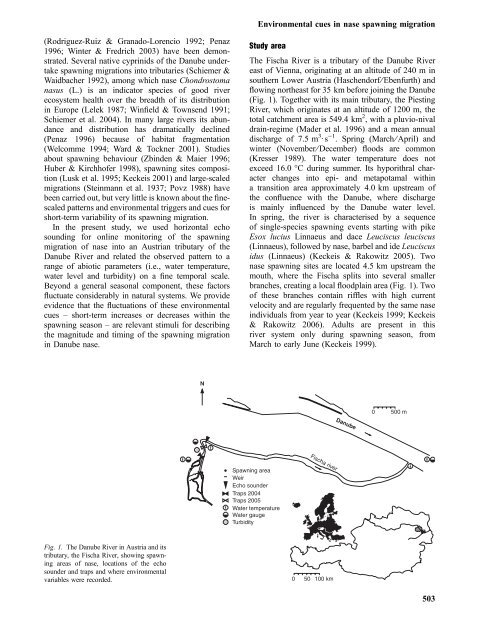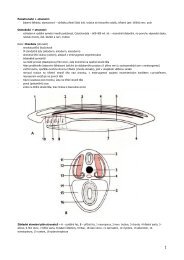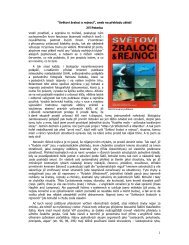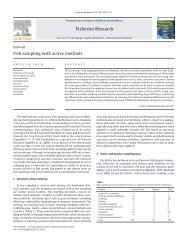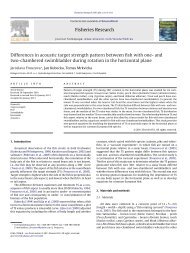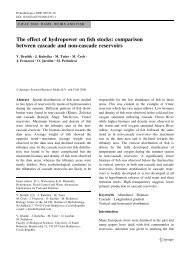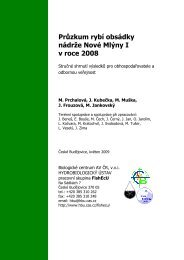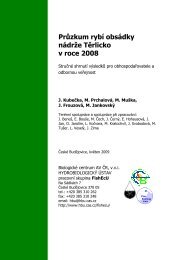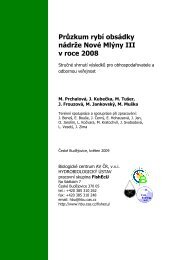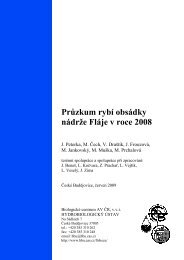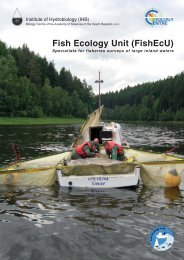Chondrostoma nasus - Biology Centre of the Academy of Sciences of
Chondrostoma nasus - Biology Centre of the Academy of Sciences of
Chondrostoma nasus - Biology Centre of the Academy of Sciences of
You also want an ePaper? Increase the reach of your titles
YUMPU automatically turns print PDFs into web optimized ePapers that Google loves.
(Rodriguez-Ruiz & Granado-Lorencio 1992; Penaz<br />
1996; Winter & Fredrich 2003) have been demonstrated.<br />
Several native cyprinids <strong>of</strong> <strong>the</strong> Danube undertake<br />
spawning migrations into tributaries (Schiemer &<br />
Waidbacher 1992), among which nase <strong>Chondrostoma</strong><br />
<strong>nasus</strong> (L.) is an indicator species <strong>of</strong> good river<br />
ecosystem health over <strong>the</strong> breadth <strong>of</strong> its distribution<br />
in Europe (Lelek 1987; Winfield & Townsend 1991;<br />
Schiemer et al. 2004). In many large rivers its abundance<br />
and distribution has dramatically declined<br />
(Penaz 1996) because <strong>of</strong> habitat fragmentation<br />
(Welcomme 1994; Ward & Tockner 2001). Studies<br />
about spawning behaviour (Zbinden & Maier 1996;<br />
Huber & Kirchh<strong>of</strong>er 1998), spawning sites composition<br />
(Lusk et al. 1995; Keckeis 2001) and large-scaled<br />
migrations (Steinmann et al. 1937; Povz 1988) have<br />
been carried out, but very little is known about <strong>the</strong> finescaled<br />
patterns and environmental triggers and cues for<br />
short-term variability <strong>of</strong> its spawning migration.<br />
In <strong>the</strong> present study, we used horizontal echo<br />
sounding for online monitoring <strong>of</strong> <strong>the</strong> spawning<br />
migration <strong>of</strong> nase into an Austrian tributary <strong>of</strong> <strong>the</strong><br />
Danube River and related <strong>the</strong> observed pattern to a<br />
range <strong>of</strong> abiotic parameters (i.e., water temperature,<br />
water level and turbidity) on a fine temporal scale.<br />
Beyond a general seasonal component, <strong>the</strong>se factors<br />
fluctuate considerably in natural systems. We provide<br />
evidence that <strong>the</strong> fluctuations <strong>of</strong> <strong>the</strong>se environmental<br />
cues – short-term increases or decreases within <strong>the</strong><br />
spawning season – are relevant stimuli for describing<br />
<strong>the</strong> magnitude and timing <strong>of</strong> <strong>the</strong> spawning migration<br />
in Danube nase.<br />
Fig. 1. The Danube River in Austria and its<br />
tributary, <strong>the</strong> Fischa River, showing spawning<br />
areas <strong>of</strong> nase, locations <strong>of</strong> <strong>the</strong> echo<br />
sounder and traps and where environmental<br />
variables were recorded.<br />
N<br />
Study area<br />
The Fischa River is a tributary <strong>of</strong> <strong>the</strong> Danube River<br />
east <strong>of</strong> Vienna, originating at an altitude <strong>of</strong> 240 m in<br />
sou<strong>the</strong>rn Lower Austria (Haschendorf ⁄ Ebenfurth) and<br />
flowing nor<strong>the</strong>ast for 35 km before joining <strong>the</strong> Danube<br />
(Fig. 1). Toge<strong>the</strong>r with its main tributary, <strong>the</strong> Piesting<br />
River, which originates at an altitude <strong>of</strong> 1200 m, <strong>the</strong><br />
total catchment area is 549.4 km 2 , with a pluvio-nival<br />
drain-regime (Mader et al. 1996) and a mean annual<br />
discharge <strong>of</strong> 7.5 m 3 Æ s )1 . Spring (March ⁄ April) and<br />
winter (November ⁄ December) floods are common<br />
(Kresser 1989). The water temperature does not<br />
exceed 16.0 °C during summer. Its hyporithral character<br />
changes into epi- and metapotamal within<br />
a transition area approximately 4.0 km upstream <strong>of</strong><br />
<strong>the</strong> confluence with <strong>the</strong> Danube, where discharge<br />
is mainly influenced by <strong>the</strong> Danube water level.<br />
In spring, <strong>the</strong> river is characterised by a sequence<br />
<strong>of</strong> single-species spawning events starting with pike<br />
Esox lucius Linnaeus and dace Leuciscus leuciscus<br />
(Linnaeus), followed by nase, barbel and ide Leuciscus<br />
idus (Linnaeus) (Keckeis & Rakowitz 2005). Two<br />
nase spawning sites are located 4.5 km upstream <strong>the</strong><br />
mouth, where <strong>the</strong> Fischa splits into several smaller<br />
branches, creating a local floodplain area (Fig. 1). Two<br />
<strong>of</strong> <strong>the</strong>se branches contain riffles with high current<br />
velocity and are regularly frequented by <strong>the</strong> same nase<br />
individuals from year to year (Keckeis 1999; Keckeis<br />
& Rakowitz 2006). Adults are present in this<br />
river system only during spawning season, from<br />
March to early June (Keckeis 1999).<br />
Spawning area<br />
Weir<br />
Echo sounder<br />
Traps 2004<br />
Traps 2005<br />
Water temperature<br />
Water gauge<br />
Turbidity<br />
Environmental cues in nase spawning migration<br />
Fischa river<br />
0 50 100 km<br />
Danube<br />
0 500 m<br />
503


